Malcom Durham Funny Car at Aquasco Speedway
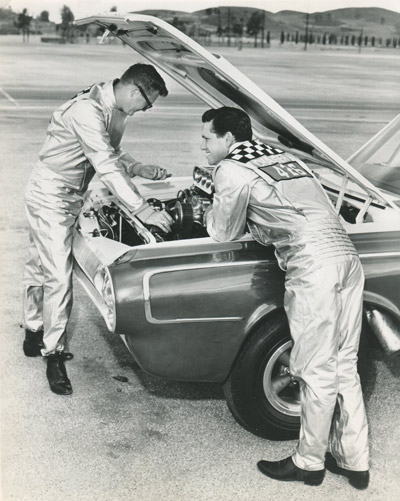
Jim Johnson and Jimmy Nix suited up; the firesuits were mostly for evidence.
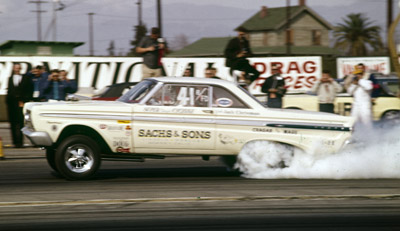
Jack Chrisman'southward Comet was a race car, shown here running in B/FD in Pomona.
Well, information technology appears that in that location's nothing similar an article near something or someone beingness the first to get anybody all worked up nigh whether or not it really was. I'm quickly finding that tracing the roots to the "first Funny Motorcar" might be similar science's long-running effort to pinpoint the outset "human" based on physical characteristics and abilities lonely. I dearest it when a plan comes together.
So allow me to throw a piddling more gasoline on the fire.
Did the Jimmy Nix- and Jim Johnson-driven Dodge Chargers I wrote almost last week precede Jack Chrisman'southward Comet? Absolutely. A lot of sources state that Ford's Fran Hernandez had Chrisman build the Comet specifically to beat the Dodges and to shadow them as they went around the country and endeavour to goad them into running caput to head.
But was Chrisman's motorcar more than like what we know today equally a Funny Car because information technology ran on nitromethane and had directly drive, whereas the Chargers ran on gas with automatic transmissions? No dubiety.
Did either wait like or were they built similar what we know today as a Funny Car? No. The tube-frame, flip-height wait did not come into vogue until 1966 with the Comets of Chrisman, Don Nicholson, Eddie Schartman, and Kenz & Leslie.
Was anyone calling them "funny cars" at the time? At that place's anecdotal information about Hernandez telling Chrisman to get out and beat out those "funny" Dodges at their own game, just, realistically, those Chargers were not all that funny looking. In fact, other than the injector scoop protruding simply slightly higher up the hood line and the by and large-for-show parachutes that blossomed at the end of each run (mandatory, according to Johnson), the Chargers were pretty stock-actualization. They did not have contradistinct wheelbases that created a "funny" appearance, nor did Chrisman's Comet. In fact, in a Hot Rod magazine commodity nearly the Sachs & Sons Comet, Chrisman specifically noted that he tried to retain equally many stock pieces as possible.
The 7 Chryslers that showed up at AHRA's 1965 Winternationals did have contradistinct wheelbases – the rear beam moved forrard past more than a human foot and the front wheels pushed forward by ten inches – and certainly looked more "funny" than the Chargers or Chrisman'south Comet, merely the class certainly did not exist past name. According to 1 business relationship I found online, their bodies were acid-dipped, the forepart fenders, doors, dash, hood, and deck lid were fiberglass, and the glass windows had been replaced by lightweight plastic. Nevertheless they did not compete in a class chosen Funny Car but more likely as Super Stockers or some sort of special "mill showdown" type of race.
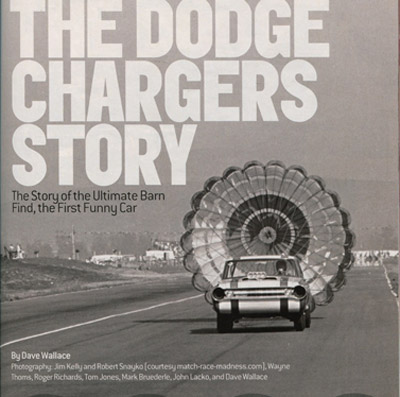
Fortunately, there is a small community of elevate racing history experts in my circle of pals, so I called on a couple of them to weigh in. Dave Wallace, in my opinion one of the truthful deans of drag racing history, has authored articles on the subject – including a really nice one nigh the Dodge Chargers, which originally appeared in Hot Rod magazine in 2005 but is reprinted in the current (and, sadly, last) issue of Elapsed Times on newsstands now – and has firsthand knowledge of the era.
"Having not but lived through the stock-to-Funny Car evolution but working at tracks (since 1961) and starting to write about these things (since 1964), I was lucky to closely observe that unabridged procedure," he wrote. "It's always perplexed me how even many people who consider Chrisman's Comet to be the first blown-fuel funny machine (lowercase) refuse to recognize the three Dodges that preceded and, in fact, directly inspired FoMoCo to back Chrisman (to break the 150-mph bulwark before i of the 141-mph Chargers got at that place first). Since Chrisman'south Comet was built specifically to compete with the Contrivance Chargers, surely the minor differences – e.g., fuel type and transmission – don't disqualify the cars that started the whole trend past touring widely and demonstrating to local stocker hitters everywhere that bolting on a blower made information technology possible to race for coin and fame instead of cheap trophies and record certificates."
"Flyin' Phil" Elliott, another well-respected guy with an encyclopedic cognition who has covered the sport for decades, also chimed in. "The Contrivance Chargers were not AWB [altered wheelbase]. Chrisman's Comet was also non AWB, and although these are all role of the history of the move, were not 'funny cars' per se. Information technology has been an arguable, semantic signal BUT quite important withal. The actual name possibly/probably could take been something coined by a hyped-upward journalist with a phrase such as, 'Those new Dodges/Plymouths sure wait funny.' There are likewise the ii theories that the term was very derogatory: ane coming from the hot/wire-wheel racers who failed to see much sense of humor in the e'er-more popular stockers, and the other from an edict laid down by Hernandez, who stated emphatically that his factory teams were not to friction match race 'those funny cars.'
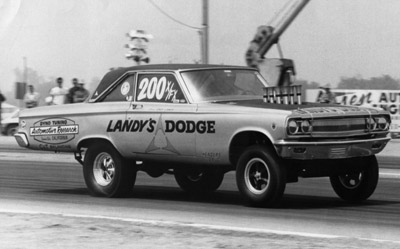
Dick Landy's injected FXer looked more "funny" than the Chargers or Comet.
"That said, I suggest that the term 'funny car' describes what has become a almost mystical ideology, one that has evolved far beyond the original intent. The 'movement' came during a third stage of drag race evolvement, one that rapidly snowballed out of Detroit'due south horsepower race. And, having lived and experienced information technology, approximately five years after I viewed my kickoff drag race, I can tell y'all that seeing the touring AWB/AFX grouping (Sox & Martin, Landy, [Cecil] Yother, [Hayden] Proffitt, [Malcolm] Durham, and about twenty more than, etc.) in August of 1965 changed my life."
Wallace also pointed out that no existing grade in drag racing retains its original proper noun; e.g., gassers were "hot stockers"; dragsters were called "track" and even "lakesters"; altereds were "hot roadsters" and "hot coupes/sedans." Keeping that in mind, Wallace supposes that it might not have been until Dick Landy unveiled his wild, altered-wheelbase '64 Dodge Super Stocker tardily in 1964 (after Chrisman had run in Indy) that the cars began to gain the nickname and, patently, even longer before the sanctioning bodies sanctioned a category with the name in uppercase messages (in NHRA's example, belatedly 1966).
(Yet I heard from Jack "JA Approved" Redd, a longtime East Coast reporter/photographer/bon vivant, who claims that the term was loosely coined in 1964 at Maryland's Aquasco Speedway when runway employee Alvin Johnson offset saw Chrisman'due south car and was said to proclaim, 'Human, that a funny-looking car!' and that the first race always advertised as a "Funny Car" meet was staged at Aquasco by promoter Julio Marra in 1965. I cannot ostend or disprove any of this.)
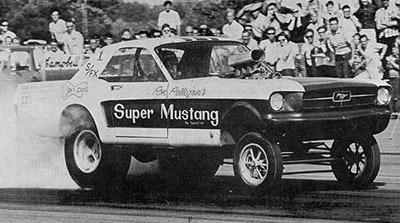
Ron Pellegrini'due south Super Mustang was an all-fiberglass nitroburner.
Into the fray comes my old buddy Ron Pellegrini -- who has raced everything from gas dragsters to A/FXers to Funny Cars and even Tommy Ivo'south 4-engine Showboat -- who put some peel into the game by suggesting that it was in fact his Super Mustang that has a claim to being the first Funny Car inasmuch equally information technology had an all-fiberglass trunk (albeit two pieces), a tube chassis, and a setback supercharged engine burning nitro in 1965, a year before the flip-top Comets.
Later watching what was beginning to happen all around them, Pellegrini proposed to Ford Racing chief Jacque Passino in belatedly 1964 that he take what the Dodges were doing to the next stride by adding a tube-frame chassis and putting Ford's hot new Mustang body atop it. Ford decided to pass – thinking the automobile would be likewise light and unsafe – but Pellegrini had already set the wheels in motion, taking an off-the-lot Mustang to a friend's fiberglass store (which later led directly to Pellegrini founding Fiberglass Ltd., the premier builder of Funny Car bodies) to build a mold, then mounting the body to the Dennison, Arlasky, and Knox fuel roadster chassis he had purchased. Voila! It'south a Funny Car, correct?
And then the debate rages on, just it'southward non likely to end with a solid conclusion.

Jack Chrisman is no longer around to fence the point, though several of his longtime friends and assembly, including Insider readers Mike Kopmanis and Kim Welch, firmly believe that Chrisman'due south Comet rightly should wearable the crown.
Fortunately for me, Jim Johnson is still around – alive and boot and still driving for a living, every bit an escort driver for oversize loads. His girl, Dori Lewis, passed along his telephone number, and I was surely eager to get his have on the discussion.
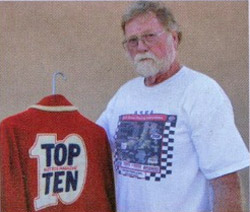
Jim Johnson (photo courtesy of Hot Rod)
He prefaced our chat – admirably conducted while he was doing escort duty, our conversation interrupted a few times by incoming and approachable radio calls -- past noting that he was wearing a T-shirt picturing the motorcar and emblazoned with the words "The Showtime" and went on to offering a off-white and interesting assessment of Funny Car lineage.
Johnson doesn't recall the kickoff fourth dimension he heard the phrase "funny machine" used in conjunction with either his Charger or Chrisman's Comet and noted that even before them, some of the Factory Experimental guys were toying with altered-wheelbase cars that certainly looked "funny." In Johnson's view, the departure betwixt a funny-looking car and anything that might be considered a "funny car" was the supercharger.
"The fuel-racing dragster guys all want to say it was Jack'southward car considering he ran fuel and loftier-gear-only similar them, and, to exist fair, I loved Jack and thought his car was amazing, merely it probably never would have been built if it wasn't for our cars.
"Our cars were never really designed to be race cars; they were a promotion past Dodge to go people to purchase more Contrivance cars, which is one reason nosotros were not allowed to race anyone simply one another. There also was a prophylactic concern from the people at Contrivance for what any motorcar that was racing usa might practice as far as control went. Nosotros also weren't allowed to do things to the cars to make them faster – similar moving the engine farther back – because Dodge wanted to maintain a expect as close to stock equally we could.
"A lot of people desire to say we weren't allowed to run against Jack because Contrivance was afraid we'd lose, but I would have loved to. In the early function of that year, before Jack really got the motorcar figured out, it was more tire smoke and racket than functioning, and I honestly think we could accept browbeaten him. He might have out-mile-per-houred u.s.a., but I don't think he would have browbeaten the states to the finish line.
"But to answer your original question, I think that anyone who was in any kind of program that progressed the class was part of it, and Jack certainly took what we were doing one pace further. I'k not going to say we were the first funny cars considering that might have come up from those contradistinct-wheelbased cars that came before united states of america, just I'one thousand sticking with the fact that ours were the beginning mill-sponsored, supercharged race cars that led to the form we know today equally Funny Car."

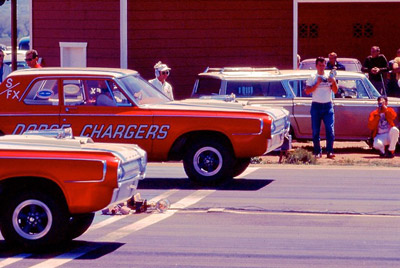
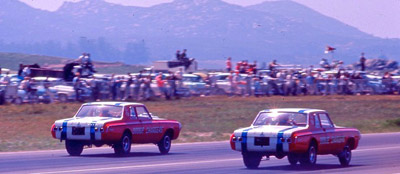
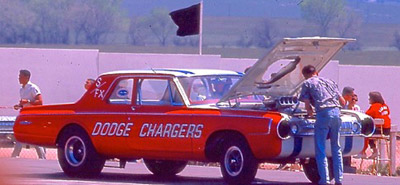
I received the photos at right of the Cypher/Johnson Dodge Chargers running at San Diego Raceway in 1964 from reader Rich Fritz, and they are the first colour action photos I have ever seen of the cars and downright cool. I asked Rich to share his story.
"It was in March 1964, and I was 20 years immature and excited to see what these new mystery Mopar Chargers were all well-nigh. Information technology was a beautiful, nice, sunny, warm spring Ramona day. The raceway actually ran parallel to the Ramona Airdrome in those days.
"The anticipation was pretty intense equally nosotros were wondering how quick these S/FX factory cars were. Information technology did not take long to find out! When they rolled these beauties off the trailers and started setting them upward to run, we all wanted to see as much as we could, but for somewhat obvious reasons, they kept everybody back from eyeballing too much.
"So they finally got into position on the line, and the Chrondek timing Tree started counting downwardly to the green calorie-free, and the thundering Mopars were revving upwards for quick exit from the box. Then, off they went, just as straight and controlled equally any Mopar of that class and size we had e'er seen. I didn't retrieve the exact east.t. and speed – somewhere in the eleven-2nd range, and the speed was somewhere in the 130-mph stratosphere – just information technology was the fastest, concentrated-automobile drag race I was ever to witness in those early on days of drag racing.
"It was the best drag race I had ever witnessed with my 20-year-old eyes, and everyone was showing quite a range of emotion, from disbelief to large, wide grins and cheers. I was glad they made 2 more than runs, but I was in some degree of shock all day."
It was at San Diego Raceway – and I'thousand non certain it was the day of Fritz's photos – that Nada crashed his Charger. As noted, the cars ran Torqueflite transmissions, shifted by the infamous dashboard push buttons, but Goose egg was either unaware or forgot that in the process of making them race-ready, the buttons were reassigned so that "Bulldoze" was actually 1st gear and "Kickoff" was actually high gear ("Second" was still 2nd). He launched in what was high, and the machine bogged; he carried on with the run, merely, of course, when he went for high gear, he got 1st instead. The tires locked upwards, and he crashed. That car was repaired and carried on. Afterward that year, another Charger was destroyed while riding atop a car carrier when the truck driver tried to pass below a low bridge.
Johnson thinks it was his automobile that was destroyed, but Wallace's article opines it was the team's 3rd motorcar – known as "the bumper car" because it still carried the stock 330 bumpers whose original purpose was as a display car for dealerships – that was wrecked. Aught's car – easily identifiable because of firewall modifications that Nix had made in hopes of being allowed to move the engine rearward (he was forbidden) – was discovered equally a "befouled find" in Wisconsin in 1980 and restored and passed through several hands. Johnson believes that the third automobile – be it his auto or the "bumper car" – is still out in that location somewhere.

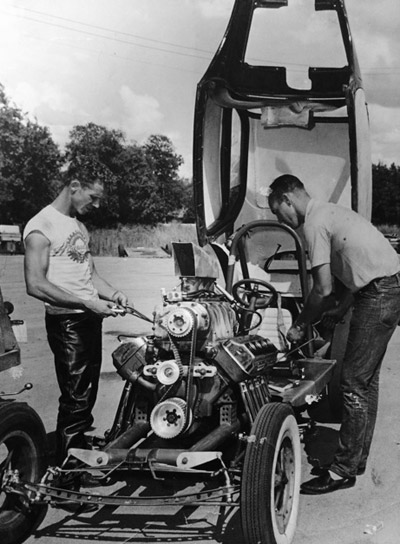
Jody Austin chimed in to the "first Funny Car" give-and-take – somewhat natural language-in-cheek, I'k assuming – that his dad, Raymond, had what he calls "the Original Flopper" in the late 1950s: A homebuilt, tube "pipe" chassis with a flip-top Fiat trunk and a supercharged engine. The automobile was towed from Texas to the 1960 Smokers Meet in Bakersfield, where it won its course over the likes of Ratican, Jackson & Stearns and a slew of other cars.
"This flopper, originally congenital in 1957, was raced in 1958, so rebuilt with a lighter frame and raced in '59 and fix the national record several times," he wrote. "As the story goes, afterward setting the A/Fuel Coupe national record, Dad was presented with an offering to take his way paid to become to Bakersfield if he could match those record times again. The car was taken back to the track, and one time again, he equaled the tape. The offer was made good, and off he went, and so winning the class there."
Newer fans may recall the Austin name every bit motorcar possessor of the Top Fueler driven past Marshall Love that lost in the third circular in Indy in 1970, falling to Jim Nicoll, who two rounds later lost that unforgettable final circular to Don Prudhomme. The senior Austin had a rear-engine race car every bit early as 1954 and went on to bulldoze for Vance Hunt earlier building his own Top Fuel car in 1962 with commuter Bob Lace, who was killed in the car in a crash at Louisiana'south LaPlace Dragway in September 1963. Other cars and drivers followed, including what is purported to be Richard Tharp'southward first ride earlier partnering with Love.
OK, Funny Car fans, that'southward where I go out you. And then whether yous're in the Johnson/Nix camp, the Chrisman military camp, the Pellegrini camp, or any other army camp, or whether y'all believe that sahelanthropus tchadensis was the first "man" or that it was human habilis, I don't take the reply. That both frustrates and amuses me.
Perchance next we could talk about the origins of the term "drag race." Or not.
Thanks for reading and chiming in.
whittemorealed1977.blogspot.com
Source: https://www.nhra.com/news/2016/funny-cars-who-s-first-i-dunno
0 Response to "Malcom Durham Funny Car at Aquasco Speedway"
Post a Comment